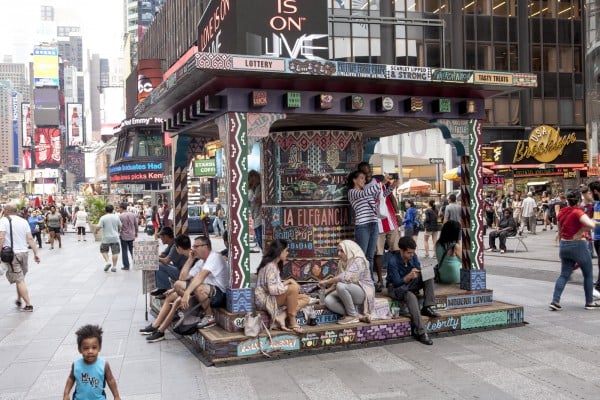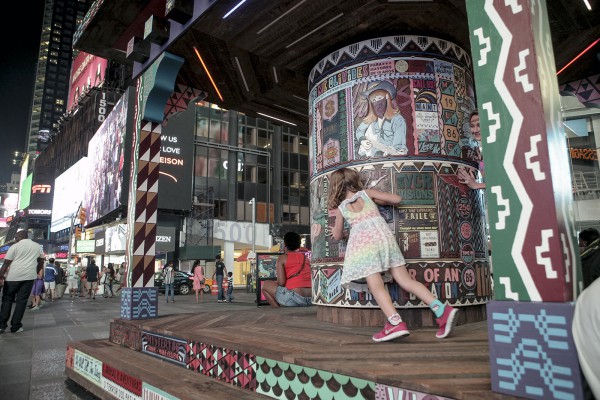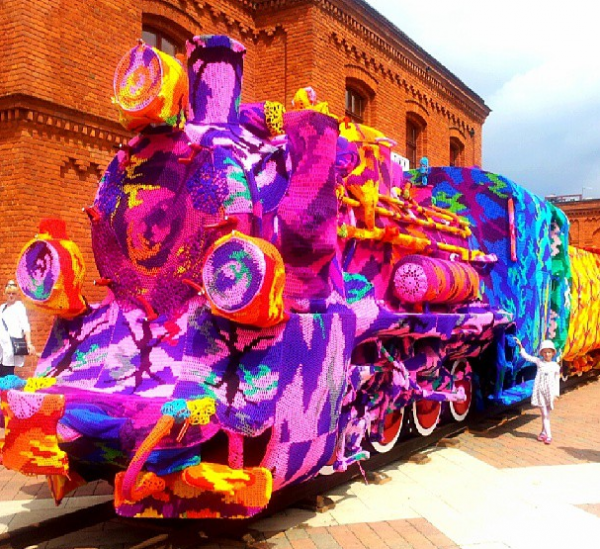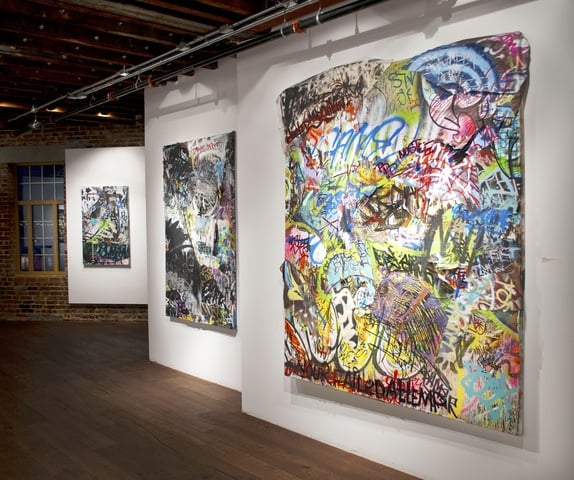People
Anthony Haden-Guest’s Intrepid Lives of the Street Artists, Part IV
Half of the Street artists out there want to be artists, and half just want the fame.

Image: Courtesy of the artists.
Half of the Street artists out there want to be artists, and half just want the fame.

Anthony Haden-Guest

This is the last in a four-part series in which Anthony Haden-Guest engages Street artists in dialogue about their practice from the 1960s to today. (For more in this series, check out the first, second, and third parts).
The Future of Street Art
As world culture grows ever more visual, Street art grows ever huger. Check out the world’s trouble spots and you’ll see the walls sprouting words and pictures. Last year, Invader, the Paris-based Street artist, who took his name from the game, Space Invaders, had a piece installed on an International Space Station module. Liliane Lijn, the London-based American artist, formerly artist-in-residence at NASA, is planning a laser projection of the word ‘she’ on the moon.
What’s next? Practitioners of the trade, as you might expect, differ. Both with respect to their views on the future of Street art and with respect to their views on the future ‘in’ Street art.
AHG
How many of the guys you were painting with on the Chicago street had been hoping for a studio-based career?
ORB
I could say half. Half want to be an artist and half just wants the fame. That’s where it’s kind of crazy, you know. They want to be known as a Destroyer…. They want to be known and put their idea out there. They don’t want to be a cliché and be an artist. And the other half want to become a studio artist. Like me! I want to become a studio artist. I want to have a space where I can create and not worry about the lease. And not worry about getting in trouble. Or getting shot at. You know there’ve been situations where I’ve been faced with a gun. Store owners. I understand when you’re messing up their stores. But at the same time you’re doing quality work. But you’re still messing them up.”
AHG
So the vandalism element is of no interest to you?
ORB
Vandalism it is. It is, it is.
AHG
But that, in itself, does not interest you?
ORB
I did it so long that it got old. It got old. It gets old after a while. After you go through a whole city and you did it over and over again. And you move to another city and you did it over and over again, it gets old. You run out of stuff. And that’s when it becomes boring.

Faile, Wishing On You.
Image: Courtesy of the artists.
I spoke to Patrick Miller and Patrick McNeil of Faile about the sometimes iffy transition that Street artists make into fine art.
AHG
The art by the first generation of graffiti artists didn’t always work in a whitewall gallery. It often looked decorative.
Patrick Miller of Faile
That’s something graffiti culture is still figuring out, how to translate into a gallery setting. There are very few galleries doing graffiti artists that have made that transition into a studio practice. Because so much of graffiti is anti-establishment, anti-gallery, it’s against everything that is about showing in a gallery. It’s the other end of the spectrum.
Patrick McNeil of Faile
Also it’s such an internal language. It only speaks to such a small community that can really understand what the tag is. And why it’s done in a lot of different visual ways. They are speaking to a just a few. And that restricts it from reaching a wider following.
AHG
Jean-Michel Basquiat, Keith Haring, and Richard Hambledon segued into just making studio art. Do you see yourselves making Street art for ever?
Patrick Miller
We certainly hope so. Studio art and street art are the important parts of our practice. And the two inform each other.
AHG
Okay. Why did you choose to work under the name “Faile”? It looks Gaelic.
Patrick Miller
We began as ‘A Life.’ We mixed the letters up. For us, it means, ‘To learn from your failures, to push forwards and succeed.’

Olek’s crocheted locomotive.
Image: Courtesy of the artist.
Olek too is comfortable navigating the double track of the street and the galleries.
AHG
Are there things you would like to do that you haven’t done?
Olek
Of course. I have a list of them. I’d like to crochet a glider. I was going to do a plane once. But the project was cancelled. I’d love to crochet a plane.

Hand-painted book covers by Stik, who in 2012 helped to create a series of works in Dulwich which became the start of the Dulwich Outdoor Gallery.
Image: via Inspiring City
AHG
Are you talking to any galleries?
Stik
I have got a show and I’m looking for a space. I am pregnant with my next show. But I don’t want to go to a gallery I don’t know. I actually want to go and meet the people. I want a gallery that understands fine art. I don’t want to get stuck in the Street art ghetto. It’s easy to get into the Street art gallery circuit.
AHG
Some Brit Street artists say, “We’re not artists, we’re vandals.” American Street artists don’t say that. Well, I haven’t heard it anyway.
Stik
Some people want to show their defiance of the government system. The fact that some artists can make their presence felt on a national or global scale without government assistance is encouraging. Some people just want to smash shit up. I can empathize with that too, but it’s not what I’m into. I think doing the government’s job better than the government is the way to move forward.
AHG
How do you mean?
Stik
I think publicly funded public art is taking a bit of a bashing from Street artists. Because Street artists do it quicker and better a lot of the time. Street art is taking the place of public art. The government spends a quarter of a million pounds funding and weeks executing a piece of artwork that nobody notices. And somebody does a piece of Street art overnight with twenty quids-worth of display paint and it becomes the landmark. There is a whole rash of public art that is designed by committee. PC public art that nobody could object to but that nobody particularly likes…. There’s nothing like the renegade spirit for creating great works of art. I have a conflict here because I believe in group decisions. And when I’m doing a piece in public, I want to get at least some sort of input from the people in that area. I choose my palette from that area or I’ll choose the subject matter from that area. And I’ll talk to people and see what that area has. But there is a point when it’s just fucking, “Let me get on with it!” You know what I mean?
AHG
Legal, illegal—it’s a bit of a dance sometimes, no?
Stik
I struggle with the concept of having permission to do something. If the council says, “Yeah, okay, it’s fine to paint the wall bright orange,” maybe I’ll have the legal right to do that there. But I don’t think that necessarily gives me the moral right to impose that on the people of that area. Who the fuck am I to put my mark on this community that I don’t know? But then, sometimes the more personal something is, the more people can relate to it. There’s nothing worse than bland impersonal art which quite often is what publicly funded art becomes. There’s work that’s so bland it’s offensive. It’s blandalism.

Installation view of MInt and Serf’s Support, Therapy, and Instability.”
Image: Courtesy of the Bleecker Street Arts Club.
The blandness bothers Mint and Serf too.
Mint
It’s different now. Because it’s acceptable. There’s not really much of an underground element to it. I mean, everything is so acceptable.
Serf
It’s still underground.
AHG
There seems to be a lot of imitation graffiti around now.
Serf
Well, there’s always that—
Mint
—a derivative of derivative!
AHG
What do you do that’s derivative?
Mint
I mean, we’re like the third generation.
Serf
The second generation or the third.
AHG
So how do you deal with that?
Serf
The whole idea is, I guess, a no holds barred, kind of bathroom graffiti to really capture the essence of battle. An expression of the action, instead of the illustration of the action. So when we finished these paintings we didn’t have a place to show them and so we published this book. And over the course of the last year we’ve done book releases. We did a book release in Moscow … we did one here … we did a book release in Los Angeles. And I think we’re getting good about our exposure in the media, not to be crass about it. Because I think it was a new twist to the way you present graffiti. Graffiti, Street art, the way it’s usually presented in museums or in an institutional kind of way, it’s always decorative. And dolled up in a fashion kind of way. By the time it gets to a museum or gallery it kind of loses the sensibility of the action that you experience on the street. I think that’s really at the root of this series of works. That was kind of the idea that’s behind it. Who cares that it’s not perfect? It doesn’t have to be perfect. It can be aggressive, it can be ugly. Because graffiti is ugly. The style of living, the life of a graffiti artist is ugly. It’s not a fucking Hollywood set, you know what I mean? It’s lot of arrests, a lot of fighting, a lot of bruises, a lot of drugs, a lot of everything.
Serf
And then one day you wake up and you’re in your mid thirties. And all you have left is your name.
AHG
Your name?
Serf
It’s your name. But it’s almost like it’s not relevant.
AHG
You are showing with a guy in Chicago now?
Mint
The gallery has been around for a few years. They mostly deal with Street art derivatives.
Serf
He reached out, because he’s been following our Instagram pieces. That opened him up to our work. He basically emailed us and said I really, really respect what you’re doing. I would love to bring this to Chicago. To open up my audience to your work.
Mint
This guy in Chicago, our friend, he was really working hard, making people realize you can look at graffiti in a different light. As far as I can remember, the whole idea, the whole thing, the whole dialogue was that graffiti is not bad, it’s actually like an art form. And I remember growing up and going to art shows. And a lot of the illustrative graffiti-esque things that you see in museums, look! I’m a graffiti artist! And I’m not bad. I can do these cool illustrations of whatever. But, you know, what that is? To me that is not really truthful. I think there’s a bigger picture of reality, of what it is to be a graffiti writer, living in New York City—
Serf
—globally!
Mint
Yeah, I think globally. It’s a very outlaw lifestyle. And I think work should reflect that.
AHG
You can do that with studio work too?
Serf
We bring people over here. Instead of going to the bar, we bring the bar here. The bar is in the bathroom. You’re not really thinking about making art, it’s just your raw energy. No real thought is going into it.
Mint
You’re just responding. The reason I like nightlife, in general—and I think nightlife and graffiti have so much parallel, between each other—is because nightlife strips you down of any anxiety towards danger. You get drunk you get loose; you say things you probably wouldn’t normally say; you do things you wouldn’t normally do. And when we create these environments here, a lot of the guys who come here respond to that lack of inhibition. It becomes a response to input. It’s uncontrollable usually. So it becomes very…truthful—and not dressed up and not careful.
Which brings us to the law. Much Street art is authorized, permitted, indeed encouraged. But when it isn’t, it isn’t. Kenny Scharf was busted for tagging just a year ago. Michael Bloomberg, former Mayor of New York, pushed the NYPD—unsuccessfully—to nail Banksy. And last week Shepard Fairey had to turn himself in for illegal tagging to the Detroit police. So why do they do it? Simple. A nod to tradition. Making an illegal tag, like taking a risk, is a way of keeping the form honest.
What does Fumero see happening with Street art?
Fumero
I think it’s at the beginning of taking over. Just like all that Expressionism in the early 1980s—the colorful designs and all that. That was the big thing. Like Pop art was in the 60s. Now Street art, that’s the big art.
AHG
That’ll be a tough sell. A number of fine artists do hugely well and a great many make a living. But not many Street artists.
Fumero
Right. Very few. But it’s only going to be more, every year. Because for years people have been growing up with graffiti, growing up with Street art. On MTV, when you want a commercial hit, what do you do? You stick in some graffiti lettering real quick to get people’s attention. So it’s become mainstream that way. The corporations are taking from the street, using it, so they can be hip. So this genre of art, it’s always fresh, it’s always new. Because Street art is fine art, Graffiti, love it as I do, it has its limits. But Street art is multi-dimensional, it can absorb everything.